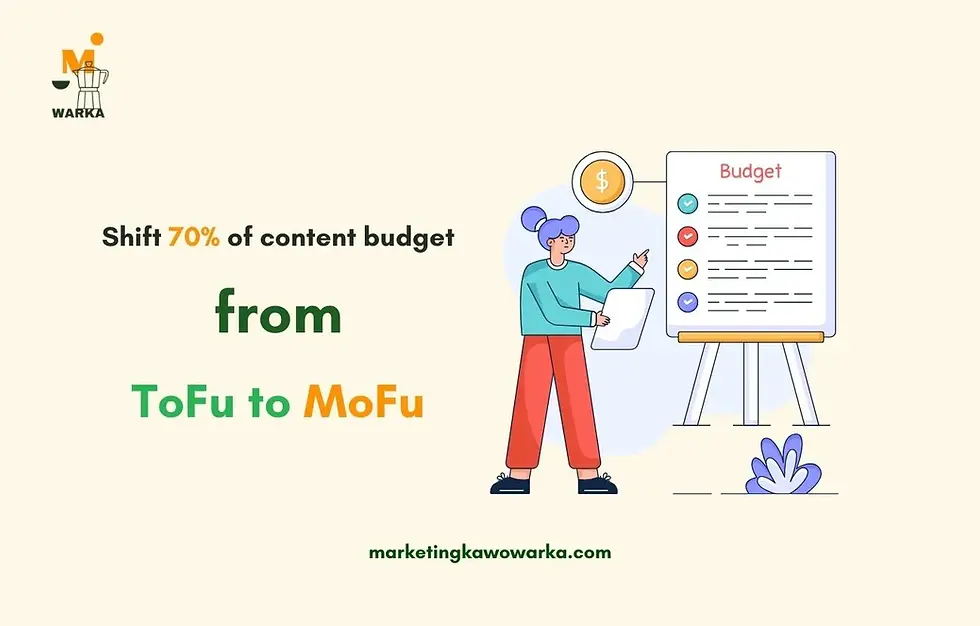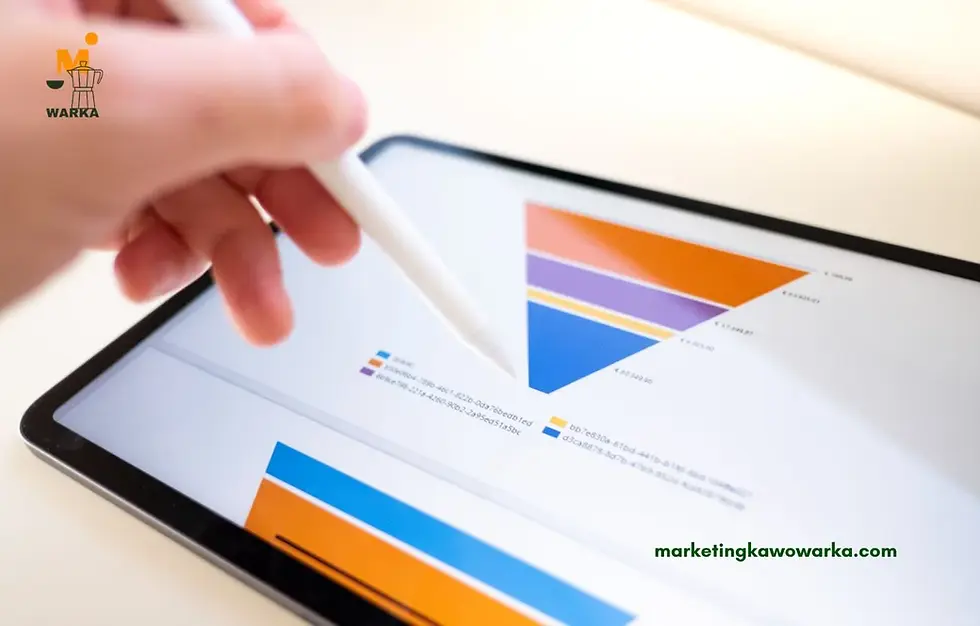The Content Funnel Crisis: Why ToFu is Dead and What to Do About It
- Olha Berezhna

- Sep 8
- 10 min read
Remember when creating an article like "What is [your topic] was your clear advantage and an opportunity to get to the top of search results? Those days are well and truly gone. Today, the beginning of the traditional marketing funnel, in which ToFu content attracted a lot of traffic, which converted into potential leads that MoFu and BoFu promoted, has been replaced by AI search.

Advanced snippets and answers at the top of the page, in the style of 100% hit in the query, ensured that more than half of Google search queries do not lead to a single click on the site.
Thus, your ToFu marketing funnel content becomes invisible and loses its functionality. An interesting tactic is to switch to more MoFu content (middle of funnel content ), but let's take everything in order. Brew a cup of coffee and let's go.
The Problem in marketing funnel strategy: AI Search Killed ToFu Traffic
Why 60% of searches never reach your website
Users want to get information quickly and specifically, not dig through hundreds of articles to find the answer to their question. AI search has solved this problem — now, users can often find the answer directly on the search results page, thanks to AI-generated knowledge presented in the form of an instant response.
Transfer this to your own habits (read: user behavior). Think about the last time you clicked on links with marketing funnel content to answer a basic query like “what is this…” or “how to calculate profitability.” Most likely, you didn’t — you got the answer immediately from the AI block on the search page.
Here’s the key: to be included in AI search, your content must be adapted for AI systems. That means structuring marketing funnel content so it provides clear, authoritative, and well-formatted knowledge that AI can easily extract, summarize, and present to users.
The zero-click search reality
Let’s figure out how algorithms have changed with content marketing and AI.
Before the AI search, namely until the end of 2022, the user would type a query in the search bar, for example, "what is a content funnel", follow the links from the top 10 (most often), spend 5 minutes reading the text, and then leave their email to get more detailed guidance. In this way, the user enters the email funnel. If their need is to resolve the pain point described in the article, the likelihood of converting them into a lead is very high.

After the launch of the AI search concept, today the situation has changed: the user types a query in the search bar, for example, "what is a content marketing funnel", then Google AI gives an extended answer based on the specified wording (exact hit of keywords), and the user does not follow articles with similar titles.
The next step for the user focuses on implementation based on their request (e.g., ‘how to build a content funnel’ or ‘framework for creating a content marketing funnel’). This means your article ‘What is a content funnel’ may not receive enough traffic, the user doesn’t enter the SEO funnel, and there is no conversion.
ToFu content ROI collapse: How to Create a Marketing Funnel
AI reviews from Google are quietly killing your traffic.
According to recent reports, the share of search queries without a click has exceeded 70%.
Companies that built their marketing funnel strategy around the ToFu, MOFu, and BoFu approach are seeing a collapse in traffic and conversion rates.
Let's do a quick checkup:
You are seeing a 40-70% drop in traffic
Your conversion rate has dropped because traffic is becoming less quality
Content production costs remain the same, but the results are getting worse and clearly not satisfying you
If you have more than 2x yes, then your content funnel has not just lost its effectiveness, it has lost the foundation on which your marketing funnel strategy was built. The top of the SEO funnel stops redirecting your visitors to the middle and lower stages, and thus the system collapses.
However, do not panic; history shows that when one strong system is destroyed, another takes its place, and the main task is to understand the rules by which the new system will operate.
The Solution: MoFu-First Marketing Funnel Strategy
If ToFu is barely breathing, then the hero's place should be taken in the middle of funnel content, which will contain specific expert content with research, analysis of target cases, and frameworks for particular processes.
Why MoFu is the New ToFu
There is an interesting conclusion: the AI implementation in Google search, forced MoFu content gives more conversions than ToFu. And although AI search gives excellent results "straight to the target", it still answers controversial questions, such as calculating the return on investment for specific business scenarios, you want to hear from specialists with experience and confirmed cases.
This is where mid-funnel marketing comes into play, where depth and comparisons are needed, and the answer cannot be presented in a few sentences or a bulleted list.

The new user path may look like this:
1. Your potential lead has basic knowledge of their issue (often from an AI search)
2. Your potential lead is looking for comparisons of solutions, benefits, cases, and expert reviews.
3. The target key becomes longer and more precise, which means the probability of getting to your middle of funnel content increases.
4. The target lead is converted into a real one faster, due to the increased density of relevant leads.
Content types that still drive clicks
An AI assistant without high-quality and relevant data will not create a working strategy for you. Most companies have problems with collecting and processing data (it is confidential, low-quality, disparate, and multi-format), which means they need ideas and solutions without additional investments in data.
Solutions to user problems based on real cases will attract attention. Highly specific articles ("AI in Email Marketing: A Ready-Made Implementation Strategy" rather than "What is AI in Email Marketing"), decision support, and interactive elements (e.g., cost calculators) will continue to engage your audience and drive engagement.
Essential MoFu Content Types
Let's take a closer look at which types of MoFu content will help you generate the highest effectiveness marketing conversion funnel.
Comparison and Buying Guides
Google's AI search may only provide a quick overview of solutions, but a detailed, comprehensive overview of current reviews, prices, pros and cons, and a conclusion based on user experience is available in MoFu articles.
What to include in such a review: feature comparisons, use case recommendations, price breakdowns, and an assessment of the complexity of implementation.
Interactive Content
These are designed to provide instant, personalized information based on data that you can change in real time.
Types of interactive content: cost-saving calculator, assessment tests and checklists, and budget planners.
Examples of cases with results
Real implementations, results, and mistakes provide invaluable experience, which is better to learn from than to experience firsthand.
What to add to explode reposts: step-by-step implementation, quantitative results, negative experience, and non-standard solutions.
Product demonstrations and step-by-step guides
Users are interested in knowing what performance your product will show in a particular scenario.
The most effective formats: product tours, video instructions with step-by-step use, and detailed reviews with real examples.
The key to the success of MoFu content is specificity and depth, so instead of general articles, try to create focused guides that will play a role for the user at the time of decision-making.

Optimized BoFu: Converting High-Intent Traffic
AI search has become the starting point for reforming not only ToFu and MoFu articles, but also BoFu (the bottom of the funnel) articles. Users who have started to get to BoFu articles are becoming more qualified; they have already conducted research, compared options, and are looking for a solution. The BoFu article is a great solution to convert this highly targeted traffic.
However, the problem is that simple conversion forms, such as "contact us," work less and less than they did even 3 years ago. Users want to see the result immediately. Let's look at the options below that can become an alternative to standard conversion hooks.
Free trials and product experiences
Users with a high level of intent want to test the solution immediately, rather than waiting for a demo call and a specialist to sell a premium subscription actively.
A trial test is a good option: you don't need a credit card and don't have to fill out long registration forms. The trial period, lasting 7-10 days, allows the user to test the solution. If they show interest, a potential call with a sales manager will be arranged.
Another excellent option for a trial test is an interactive video demo, where the user has clickable elements and thus gets acquainted with the product interface, functions, advantages, and capabilities. After such a demonstration, lead nurturing will be much easier.
Customer proof and testimonials
Users are always skeptical; reviews help you overcome this stage of mistrust and discover what they need in the product.
But bought reviews are not what you need. Thematic studies or research highlighting the results of specific companies that have used your product or service are more effective. This increases the level of trust, demonstrates the implementation timeframes, and clearly shows the "problem-solution" link in which a potential user can find themselves.
A good traditional way of reviewing is video reviews, but instead of traditional recorded short videos, you can smoothly embed your review in a podcast. Such content will expand the coverage of your target audience, and at most, it will confirm the usage statistics.
A short, but still effective solution is to integrate widgets from rating and review platforms, such as G2, Capterra, etc. Recent reviews show that your product is at the top, and you are constantly improving it.
Pricing calculators and ROI tools
Calculating profitability at the moment of decision-making helps users justify their purchase decision. The final figure can be updated in real time with changes in input data. It is essential to give the user a choice of what he wants to calculate: efficiency, returns, long-term savings, etc., and also include an explanation of the methodology to build trust.
Remember the critical point: the goal of optimized BoFu content is to help users decide in the shortest possible time and with minimal objections. Your BoFu content should match their urgency and specificity, offering immediate access and concrete evidence.
Building the SEO Funnel Flow
Writing quality articles is the key to the success of your marketing funnel strategy. However, it is equally important to find a way to combine MoFu and BoFu stages into a typical funnel.
Content Bridges Between Stages
How MoFu leads to BoFu conversions
The transition from MoFu to BoFu should be natural and not cause difficulties for the target lead in finding the hidden CTA.
A winning option is to embed BoFu offers into MoFu content. For example, in an article that provides a comparison of two CRMs, add a CTA: try the CRM for free for 14 days after describing the main advantages.
Embed lead magnets into MoFu content. For example, in a general study of industry trends, you can add a CTA for more detailed information with specific examples or an offer to review your project by experts.
Internal linking strategies
One of the best ways to build a MoFu - BoFu bridge is to create thematic clusters in which one page links to several supporting articles.
For example, a guide to choosing a CRM system links to individual reviews and case studies.
When creating content that complements each other, you create what is called a content loop, in which one guide introduces product alternatives, the second describes each product in detail, the third presents a case with real results, and the fourth calculates profitability and payback or provides trial versions.
And in this way, you guide the user through the full cycle of choosing a product. And remember that for links to both horizontal (the same type of content) and vertical (the next stage of content) articles, use relevant anchors (medium and low-frequency keys), and not just a phrase describing the value.
Distribution Marketing Funnel Strategy
Multi-channel amplification
Your MoFu content, no matter how good it is, needs to be distributed. Let's talk about the distribution strategy for such content.
This is where your LinkedIn profile comes into play, where you can share individual pieces of MoFu content, comparative findings, create carousel posts to attract attention, comment on target leads with relevant discussions, and add content to relevant thematic groups in the format of expert opinion(not advertising, I beg you).
Don't forget about platforms like Reddit, Quora, and Medium.
They don't offer a 100% guarantee (what does?), but they generate buzz in your target audience's community. In general, these platforms offer numerous potential benefits, which we'll discuss in more detail later.
In addition, if you have built your personal brand on LinkedIn or Substack (or other alternative platforms), you can involve your potential partners in creating content. This is a good way to distribute the topic you need, and one of the ways to lead nurturing.
Email integration points
Standard newsletter subscriptions show less and less efficiency, so the most advantageous option is to assess the user's intent and customize the content of the newsletter to their intent (naturally relevant to your article topic).
For example, you have created several thematic clusters in which BoFu stages are different in logic (calculation of efficiency and interactive tour). Next, segment the collected audience by intent and send the results to fans for calculating efficiency via email, including recommendations for subsequent actions.
For fans of the interactive demo, provide cases with integration stages and audience feedback. If you have advertising budgets, consider incorporating behavioral retargeting into your marketing funnel strategy. This involves assessing audience engagement with specific content types and displaying BoFu ads to users who have interacted with certain MoFu content.
In an ideal scenario, include the cross-platform retargeting:
Facebook - customer success stories;
LinkedIn - case studies from specific industries;
Google - ads targeting high-intent keywords that your content ranks for.
The key to a successful multi-channel funnel is to allow the user to smoothly transition from comparing options to calculating profitability and launching a demo version, without feeling like they've been hooked on an ad.
Updated Success Content Metrics
Today, the focus on traffic is more of a throwback. The fundamental metrics will be content engagement metrics of your customer funnel, such as:
Tool usage rate (whether they completed the calculator/estimate or left halfway through)
Content conversion to demo (this is direct attribution from management to registration)
Lead scoring speed (i.e., how quickly leads go from first touch and nurturing to closing a deal)
Don't forget to calculate the cost of customer acquisition by content type; this will give a more complete picture of which 20% of content brings 80% of the result.
Quick Content Audit Checklist
Before you rework your existing content, make sure that your current content is effective (or not effective).
Step 1
Identify your top 10 articles by traffic
Calculate your % retention and cost per lead
Look for conversion rates below 2% (these are potential articles for reworking)
Step 2
Identify key pain points in your specific industry that could become topics for MoFu articles
Audit your competitors' most effective (at least by traffic) content
Step 3
List your target audience's main objections to article topics and start writing content
Reallocate your budget from ToFu to MoFu creation, and also shift SEO costs to keywords for comparison and solution
Track your current conversion rates of test queries
Summary: How to Build an Effective Content Marketing Funnel
Companies that fail to shift their focus from ToFu to MoFu will fall behind. If you want to lead, focus on your content today.
Key Takeaways Checklist for Building Customer Funnel:
Check your current content ROI and eliminate ineffective options
Reallocate budget to content comparison and MoFu content solution
Create 2-3 interactive calculators or assessment tools
Optimize BoFu streams for immediate trial access
Track engagement quality metrics, not just traffic numbers
.png)

